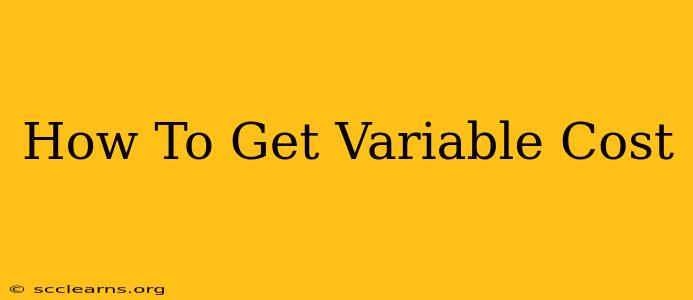Understanding variable costs is crucial for businesses of all sizes. Knowing how to calculate and manage them directly impacts profitability and strategic decision-making. This comprehensive guide will walk you through everything you need to know about determining your variable costs.
What are Variable Costs?
Variable costs are expenses that change in proportion to the level of goods or services produced by a business. Unlike fixed costs (like rent or salaries), which remain constant regardless of output, variable costs increase as production increases and decrease as production decreases.
Examples of Variable Costs:
- Raw materials: The cost of the materials directly used in production. This is often the largest component of variable costs.
- Direct labor: Wages paid to employees directly involved in production. This includes hourly workers assembling products or providing services.
- Manufacturing supplies: Items used in the production process, such as lubricants, cleaning supplies, or packaging materials.
- Sales commissions: Payments to salespeople based on the volume of sales achieved.
- Freight costs: Expenses associated with shipping goods to customers. These costs often vary depending on the quantity shipped.
How to Calculate Variable Costs
Calculating your variable costs involves identifying all the expenses that directly correlate with your production volume and then summing them up. Here's a step-by-step process:
1. Identify Variable Costs: Begin by creating a list of all your expenses. Carefully categorize each expense as either variable, fixed, or mixed. Mixed costs have both fixed and variable components (e.g., utilities).
2. Determine the Cost per Unit: For each variable cost, determine the cost per unit of production. For example, if you use 10 pounds of raw materials to produce 100 units, the cost per unit is 0.1 pounds of raw material.
3. Calculate Total Variable Costs: Once you've determined the cost per unit for each variable cost, multiply it by the number of units produced. Sum up the total variable costs for all items.
Example:
Let's say you produce 1000 widgets. Your variable costs are:
- Raw materials: $2 per widget
- Direct labor: $1 per widget
- Manufacturing supplies: $0.50 per widget
Total Variable Cost = (2 + 1 + 0.50) * 1000 = $3500
Analyzing Variable Costs: Key Insights
Understanding your variable costs offers several crucial business insights:
- Profitability Analysis: Analyzing variable costs helps you determine the break-even point, the level of production at which total revenue equals total costs.
- Pricing Strategies: Accurate variable cost data is essential for setting competitive prices that ensure profitability.
- Cost Control: Tracking variable costs enables you to identify areas where you can reduce expenses without impacting production quality.
- Strategic Decision-Making: Understanding variable costs is crucial when making decisions about production volume, expansion, or outsourcing.
Beyond the Basics: Handling Mixed Costs
Dealing with mixed costs requires a bit more finesse. You can use the following methods to separate the fixed and variable components:
- High-Low Method: This method compares the highest and lowest activity levels to estimate the variable cost per unit.
- Regression Analysis: A more sophisticated statistical method used to determine the relationship between cost and activity level.
Understanding and effectively managing your variable costs is a fundamental aspect of successful business operations. By diligently tracking and analyzing these costs, you can make informed decisions that drive profitability and sustainable growth. Remember to regularly review and update your variable cost calculations as your business evolves.

